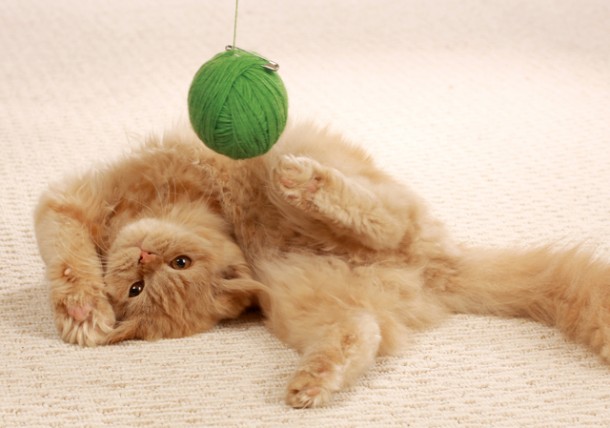How to Enrich Life for Your Indoor Cat

People sometimes mistakenly assume that cats don’t need or benefit from our attention the way our canine pals do. While dogs need our seemingly constant attention, our cats are described as being self-sufficient. This just isn’t so! Studies have shown how cats benefit from the same enrichment efforts that we provide for our dogs. Cat owners should aim to provide enrichment in three different aspects of the feline’s life—social, mental and physical.
Mental Enrichment for Cats
Cats are hunters by nature, so anything that can stimulate their hunting instincts gives their mind a nice workout. Owners can provide mental enrichment by having perches poised by windows for easy viewing. Putting a bird feeder within view can make this a special treat. You can move your cat’s food bowl to various places throughout the house so that the cat needs to “hunt” for its food. Also, consider a treat feeder that requires a cat to work to get its treat. There are many companies that sell “catios” that link the indoors with the outdoors. These completely fenced-in runs are often accessed by a “doggie-door” type of exit and allow cats access to the outdoors while maintaining the safety of being enclosed. Even though these installments can be costly and require upkeep compared to allowing cats to roam freely, the peace of mind they provide is priceless.
Physical: Exercise for Cats
Another important facet of an indoor cat’s life is exercise. Most cats are fed “free choice,” which means a bowl of food is left out for them to eat as much as they want throughout the day. Most cats won’t self-regulate, and this leads to obesity. If owners provide shelving at different heights, the physical activity of reaching a place of relaxation will be encouraged. Laser pointers and cat wands are great ways to give your cat some exercise. It’s easy to give your cat some physical activity just by aiming a laser pointer while you watch your favorite television show! Cats will often get bored with toys left out all the time. It’s important to rotate their toys as well as to take time to physically play with your cats. Catnips and cat grass are also great enrichment tools.
Socialization for Cats
Cats don’t usually respond to play-dates like dogs do. Their socialization comes from the family they live with, including any other pets that might be in the household. Many people don’t understand that the way they interact with their cat does not give them as much enrichment in this area as they need.
Watch for signs of aggression from your cat, including scratching, biting and avoidance. These behaviors often indicate overstimulation or antagonism. These behaviors don’t necessarily result from the cat being mistreated by someone but may be a plea for a change in the way we interact with them. Children should be taught to respect their cat’s boundaries and learn to pick them up gently and not pull their tails or ears. In general, interactions should be on the cat’s terms. If a cat protests to physical interaction, leave them alone. Relaxed, happy cats will request interaction at their leisure.
Without proper enrichment, cats can develop various behavioral diseases, such as idiopathic cystitis, “Pandora” syndrome and overgrooming. Owners should make a priority of creating an environment that stimulates a cat in social, physical and mental ways. Cats are wonderful pets with a depth of personality that a true cat lover can appreciate. With a little attention to detail, you can turn your cat’s living space into a life of enrichment and fulfilling stimulation.
Carol Hurst, LVT, is a graduate of McLennan Community College who lives in Houston, Texas. She works at ABC Animal & Bird Clinic.


[…] happy and healthy with fresh and engaging activities. To learn more, visit: HouzzTV, hauspanther, TexVetPets, The Cat […]